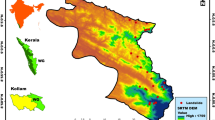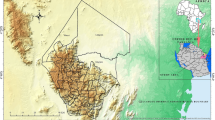Abstract
The northeast part of Turkey is prone to landslides because of the climatic conditions, as well as geologic and geomorphologic characteristics of the region. Especially, frequent landslides in the Rize province often result in significant damage to people and property. Therefore, in order to mitigate the damage from landslides and help the planners in selecting suitable locations for implementing development projects, especially in large areas, it is necessary to scientifically assess susceptible areas. In this study, the frequency ratio method and the analytical hierarchy process (AHP) were used to produce susceptibility maps. Especially, AHP gives best results because of allowing better structuring of various components, including both objective and subjective aspects and comparing them by a logical and thorough method, which involves a matrix-based pairwise comparison of the contribution of different factors for landslide. For this purpose, lithology, slope angle, slope aspect, land cover, distance to stream, drainage density, and distance to road were considered as landslide causal factors for the study area. The processing of multi-geodata sets was carried out in a raster GIS environment. Lithology was derived from the geological database and additional field studies; slope angle, slope aspect, distance to stream, distance to road and drainage density were invented from digital elevation models; land cover was produced from remote sensing imagery. In the end of study, the results of the analysis were verified using actual landslide location data. The validation results showed satisfactory agreement between the susceptibility map and the existing data on landslide locations.










Similar content being viewed by others
References
Ayalew L, Yamagishi H, Ugawa N (2004) Landslide susceptibility mapping using GIS-based weighted linear combination, the case in Tsugawa area of Agano River, Niigata Prefecture, Japan. Landslides 1:73–81
Ayalew L, Yamagishi H, Marui H, Kanno T (2005) Landslides in Sado Island of Japan: Part II. GIS-based susceptibility mapping with comparisons of results from two methods and verifications. Eng Geol 81:432–445
Cevik E, Topal T (2003) GIS-based landslide susceptibility mapping for a problematic segment of the natural gas pipeline, Hendek (Turkey). Environ Geol 44:949–962
Chung CJF, Fabbri AG (2003) Validation of spatial prediction models for landslide hazard mapping. Nat Hazards 30(3):451–472
Dai FC, Lee CF, Li J, Xu ZW (2001) Assessment of landslide susceptibility on the natural terrain of Lantau Island, Hong Kong. Environ Geol 43(3):381–391
Galli M, Ardizzone F, Cardinali M, Guzzetti F, Reichenbach R (2008) Comparing landslide inventory maps. Geomorphology 94:268–289
Guzzetti F, Carrara A, Cardinalli M, Reichenbach P (1999) Landslide hazard evaluation: a review of current techniques and their application in a multi-scale study, Central Italy. Geomorphology 31:181–216
Guzzetti F, Reichenbach P, Cardinali M, Galli M, Ardizzone F (2005) Landslide hazard assessment in the Staffora basin, northern Italian Apennines. Geomorphology 72:272–299
Karsli F, Atasoy M, Yalcin A, Reis S, Demir O, Gokceoglu C (2009) Effects of land-use changes on landslides in a landslide-prone area (Ardesen, Rize, NE Turkey). Environ Monit Assess 156:241–255
Komac M (2006) A landslide susceptibility model using the analytical hierarchy process method and multivariate statistics in perialpine Slovenia. Geomorphology 74(1–4):17–28
Lee S, Min K (2001) Statistical analysis of landslide susceptibility at Yongin, Korea. Environ Geol 40:1095–1113
Lee S, Talib JA (2005) Probabilistic landslide susceptibility and factor effect analysis. Environ Geol 47:982–990
Lee S, Choi J, Min K (2004) Probabilistic landslide hazard mapping using GIS and remote sensing data at Boun, Korea. Int J Remote Sens 25(11):2037–2052
Reis S, Yomralioglu T (2006) Detection of current and potential hazelnut (corylus) plantation areas in Trabzon, North East Turkey using GIS & RS. J Environ Biol 27(4):653–659
Saaty TL (1977) A scaling method for priorities in hierarchical structures. J Math Psychol 15:234–281
Saaty TL, Vargas GL (2001) Models, methods, concepts, and applications of the analytic hierarchy process. Kluwer Academic, Boston
Saha AK, Gupta RP, Arora MK (2002) GIS-based landslide hazard zonation in the Bhagirathi (Ganga) valey, Himalayas. Int J Remote Sens 23(2):357–369
Suzen ML, Doyuran V (2004) Data driven bivariate landslide susceptibility assessment using geographical information systems: a method and application to Asarsuyu catchment, Turkey. Eng Geol 71:303–321
Voogd H (1983) Multicriteria evaluation for urban and regional planning. Pion Ltd., London
Yalcin A (2007) Environmental impacts of landslides: a case study from East Black Sea region, Turkey. Environ Eng Sci 24(6):821–833
Yalcin A (2008) GIS-based landslide susceptibility mapping using analytical hierarchy process and bivariate statistics in Ardesen (Turkey): comparisons of results and confirmations. Catena 72:1–12
Yalcin A, Bulut F (2007) Landslide susceptibility mapping using GIS and digital photogrammetric techniques: a case study from Ardesen (NE-Turkey). Nat Hazards 41:201–226
Yalcin A, Reis S, Aydinoglu AC, Yomralioglu T (2011) A GIS-based comparative study of frequency ratio, analytical hierarchy process, bivariate statistics and logistics regression methods for landslide susceptibility mapping in Trabzon, NE Turkey. Catena 85:274–287
Acknowledgments
The authors would like to thank The Scientific and Technological Research Council of Turkey (TUBITAK; project number: 106Y018) for its financial support.
Author information
Authors and Affiliations
Corresponding author
Rights and permissions
About this article
Cite this article
Reis, S., Yalcin, A., Atasoy, M. et al. Remote sensing and GIS-based landslide susceptibility mapping using frequency ratio and analytical hierarchy methods in Rize province (NE Turkey). Environ Earth Sci 66, 2063–2073 (2012). https://doi.org/10.1007/s12665-011-1432-y
Received:
Accepted:
Published:
Issue Date:
DOI: https://doi.org/10.1007/s12665-011-1432-y




